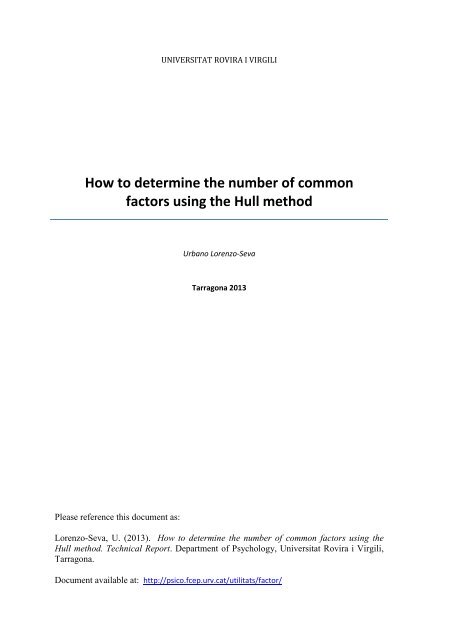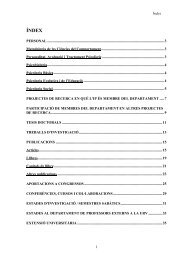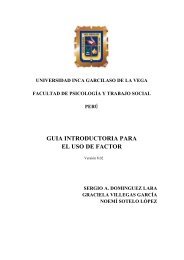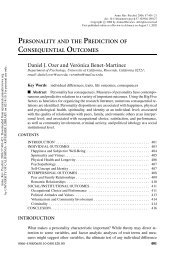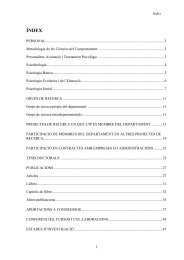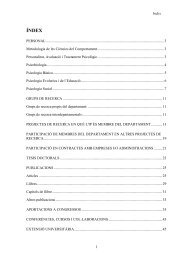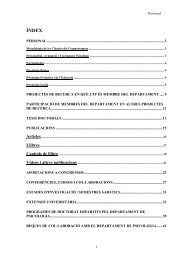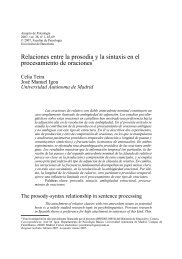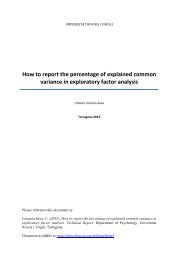How to determine the number of common factors using the Hull ...
How to determine the number of common factors using the Hull ...
How to determine the number of common factors using the Hull ...
Create successful ePaper yourself
Turn your PDF publications into a flip-book with our unique Google optimized e-Paper software.
UNIVERSITAT ROVIRA I VIRGILI<br />
<strong>How</strong> <strong>to</strong> <strong>determine</strong> <strong>the</strong> <strong>number</strong> <strong>of</strong> <strong>common</strong><br />
fac<strong>to</strong>rs <strong>using</strong> <strong>the</strong> <strong>Hull</strong> method<br />
Please reference this document as:<br />
Urbano Lorenzo-Seva<br />
Tarragona 2013<br />
Lorenzo-Seva, U. (2013). <strong>How</strong> <strong>to</strong> <strong>determine</strong> <strong>the</strong> <strong>number</strong> <strong>of</strong> <strong>common</strong> fac<strong>to</strong>rs <strong>using</strong> <strong>the</strong><br />
<strong>Hull</strong> method. Technical Report. Department <strong>of</strong> Psychology, Universitat Rovira i Virgili,<br />
Tarragona.<br />
Document available at: http://psico.fcep.urv.cat/utilitats/fac<strong>to</strong>r/
1<br />
<strong>How</strong> <strong>to</strong> <strong>determine</strong> <strong>the</strong> <strong>number</strong> <strong>of</strong> <strong>common</strong> fac<strong>to</strong>rs <strong>using</strong> <strong>Hull</strong> method<br />
<strong>Hull</strong> is very much like a typical scree test: it looks for an elbow in a scree graph. Please<br />
note that we represent <strong>the</strong> scree graph in an inverted position (i.e., <strong>the</strong> graph represents<br />
increasing fit values) with respect <strong>to</strong> <strong>the</strong> classical Cattle scree test. When looking for an<br />
elbow, <strong>the</strong> idea is <strong>to</strong> discard (1) <strong>the</strong> most complex solutions, and (2) <strong>the</strong> solutions that<br />
cannot be considered an “elbow”even if <strong>the</strong>y are not <strong>to</strong>o complex. For <strong>the</strong> first decision,<br />
<strong>Hull</strong> uses Parallel Analysis (PA): <strong>Hull</strong> looks for an elbow between 1 and <strong>the</strong> <strong>number</strong> <strong>of</strong><br />
dimensions suggested by PA. The second decision is trickier and is based on <strong>the</strong> idea that<br />
an elbow is <strong>to</strong> some extent a salient solution. For example, in this graph:<br />
f values<br />
.50<br />
.45<br />
.40<br />
.35<br />
.30<br />
.25<br />
.20<br />
.15<br />
.10<br />
.05<br />
.00<br />
0 500 1000 1500<br />
fp parameters<br />
Figure 1. Graphical representation <strong>of</strong> <strong>the</strong> <strong>Hull</strong> method’s outcome<br />
an imaginary line (which must be as straight as possible) is drawn between <strong>the</strong> points that<br />
represent each solution. Note that solutions between 2 and 5 are below this imaginary<br />
straight line: in this sense, <strong>the</strong>y are not at <strong>the</strong> “<strong>to</strong>p <strong>of</strong> <strong>the</strong> hull” defined by this imaginary<br />
line. As <strong>the</strong>y are not at <strong>the</strong> <strong>to</strong>p <strong>of</strong> <strong>the</strong> hull, <strong>the</strong>y cannot be an elbow, and <strong>the</strong>y are<br />
immediately discarded as <strong>the</strong> possible elbow in <strong>the</strong> scree graph. When <strong>the</strong> solutions at <strong>the</strong><br />
<strong>to</strong>p <strong>of</strong> <strong>the</strong> hull have been identified, <strong>the</strong> solution that shows <strong>the</strong> best compromise between<br />
good fit and low complexity is selected as <strong>the</strong> “elbow”.<br />
As a consequence, only a few solutions are considered as “possible” elbows. The<br />
outcome in Fac<strong>to</strong>r reports <strong>the</strong> selected elbow, and <strong>the</strong> solutions at <strong>the</strong> <strong>to</strong>p <strong>of</strong> <strong>the</strong> hull in<br />
Urbano Lorenzo-Seva
<strong>How</strong> <strong>to</strong> <strong>determine</strong> <strong>the</strong> <strong>number</strong> <strong>of</strong> <strong>common</strong> fac<strong>to</strong>rs <strong>using</strong> <strong>Hull</strong> method<br />
case <strong>the</strong> researcher wants <strong>to</strong> inspect whe<strong>the</strong>r any <strong>of</strong> <strong>the</strong> o<strong>the</strong>r solutions at <strong>the</strong> <strong>to</strong>p <strong>of</strong> <strong>the</strong><br />
hull turn out <strong>to</strong> be more advisable <strong>using</strong> substantive criteria (for example, a more<br />
interpretable rotated loading matrix).<br />
The <strong>Hull</strong> method can be based on different goodness-<strong>of</strong>-fit indices, which yield different<br />
<strong>Hull</strong> variants. <strong>Hull</strong>-CFI (i.e., <strong>Hull</strong> based on CFI) and <strong>Hull</strong>-CAF (i.e., <strong>Hull</strong> based on<br />
KMO) were <strong>the</strong> most successful methods in our study. <strong>Hull</strong>-CFI can be applied only<br />
when ML and ULS fac<strong>to</strong>r extraction are used, whereas <strong>Hull</strong>-CAF can be used with any<br />
fac<strong>to</strong>r extraction method. The performance <strong>of</strong> <strong>the</strong> <strong>Hull</strong> variants seems <strong>to</strong> improve as <strong>the</strong><br />
sample size increases, and <strong>the</strong> <strong>number</strong> <strong>of</strong> observed variables per fac<strong>to</strong>r increases. As a<br />
consequence, <strong>Hull</strong> is suitable approach when large datasets are analysed: with this kind <strong>of</strong><br />
dataset, it outperforms such classical methods as Parallel Analysis.<br />
For a detailed explanation <strong>of</strong> <strong>the</strong> <strong>Hull</strong> method, see Lorenzo-Seva, Timmerman, and Kiers<br />
(2011).<br />
Urbano Lorenzo-Seva
3<br />
<strong>How</strong> <strong>to</strong> <strong>determine</strong> <strong>the</strong> <strong>number</strong> <strong>of</strong> <strong>common</strong> fac<strong>to</strong>rs <strong>using</strong> <strong>Hull</strong> method<br />
References<br />
Lorenzo-Seva, U.; Timmerman, M.E.; Kiers, H. A. L. (2011). The <strong>Hull</strong> method for<br />
selecting <strong>the</strong> <strong>number</strong> <strong>of</strong> <strong>common</strong> fac<strong>to</strong>rs. Multivariate Behavioral Research,<br />
46(2), 340-364. ISSN: 0027-3171.<br />
Urbano Lorenzo-Seva


